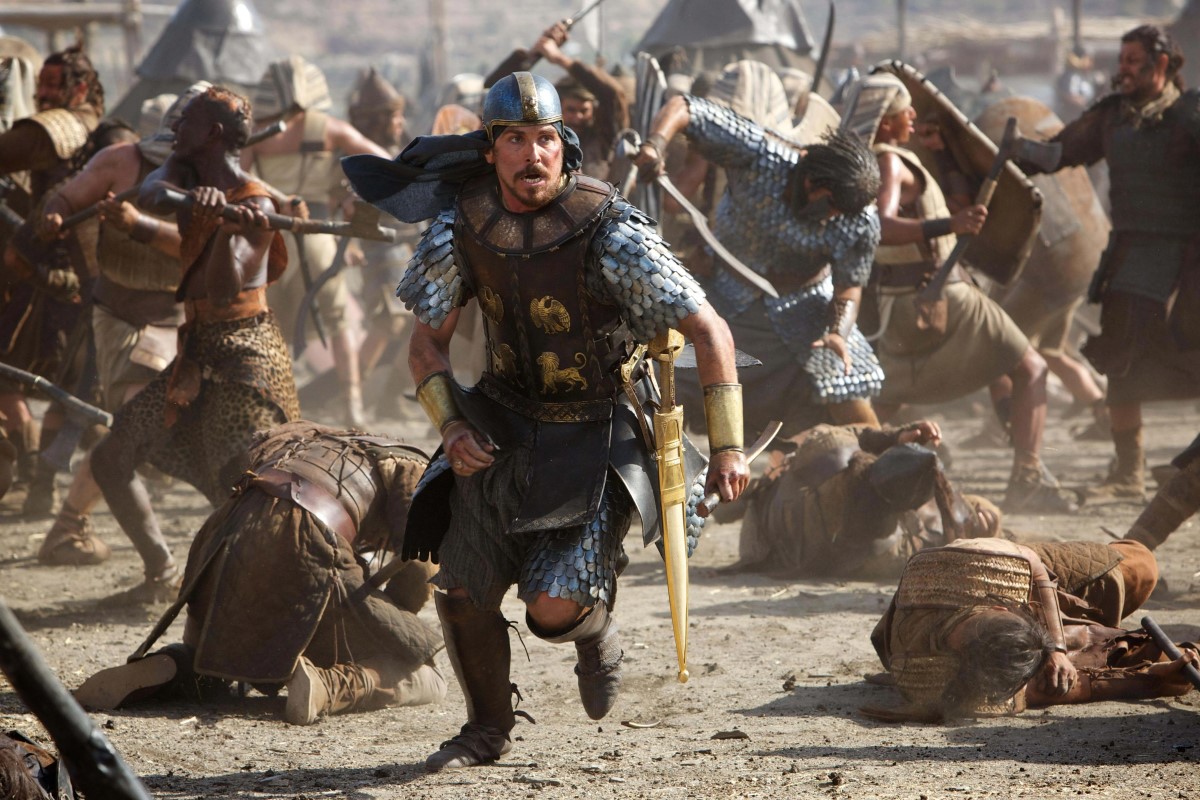One of the big questions in Blade Runner is “What does it mean to be Human?” John W. Whitehead has a look at this and related questions in Blade Runner couched in a view of the postmodern world.
by John W. Whitehead
Man has made his match.—Poster for Blade Runner
We’re not computers, Sebastian. We’re physical.—Roy Batty
It was twenty years ago that Ridley Scott’s Blade Runner (R, 117 minutes, 1982) finally wrapped production and was screened before test audiences—who, by the way, routinely panned and even attacked the film. And even though it opened in over 1,200 theaters in the summer of 1982, it was a certified box office flop. Virtually no one, it seems, liked Blade Runner. Fortunately, however, the film’s discovery on cable TV, video cassette and in revival houses revealed not only a cult film par excellence but an emotionally challenging, thematically complex work whose ideas and subtexts are just as startling as its now famous production designs.
Set in Los Angeles in the year 2019, Blade Runner shows a world where the sun no longer shines. Instead, a constant rainy drizzle adds to the dark character of this futuristic landscape. The opening shot’s aerial perspective suggests a modern Los Angeles, but the audience soon discovers a very different city—the endless archipelago of suburbs have been replaced by a dark and ominous landscape lit only by occasional flare-ups of burning gas at oil refineries. An energy shortage has crippled life in the future. The earth is decayed, and millions of people have been forced to colonize other planets. Those who remain behind live in huge cities consisting of a conglomeration of new buildings four hundred stories high and the dilapidated remains of earlier times.
The streets teem with Orientals, Hare Krishnas and men in fezzes, all lit by a lurid blaze of flashing neon. The crunch and crush of modern population seems overwhelming and totally dehumanizing. Genetic engineering has become one of the earth’s major industries, with humans now assuming the role of “maker” and “creator.” Since most of the world’s animals have become extinct, genetic engineers now produce artificial animals. And artificial humans called “replicants” have been created to do the difficult, hazardous and often tedious work necessary in the colonies on other planets.
If Michelangelo were alive in Ridley Scott’s future world, rather than portray God on the ceiling of the Sistine Chapel, he would likely paint the human creators of the Tyrell Corporation, the world’s leading manufacturer of replicants. The corporation has recently introduced the “Nexus-6,” a replicant with far greater strength and intelligence than human beings. These latest-model replicants represent an obvious potential danger to human society, and their introduction on earth—an offense calling for the death penalty—has been strictly outlawed.
When the replicants somehow make their way back to earth, they are systematically “retired” (but not “killed” since they are inhuman) by special detectives or “blade runners” trained to track down and liquidate the infiltrators. As Scott explains: “A replicant is essentially a human being, an all-flesh culture, that is very advanced and highly perfected. That’s the odd dichotomy of the whole story. The detective’s job is to be a kind of policeman but also an exterminator, if necessary. His job is to hunt replicants who happen to find their way into the city. They have no right to be there because the replicants were originally developed for off-world situations, military, industrial, mining. They are kind of a second-class generation developed for inhospitable environments and dangerous or boring work.”
Police receive an emergency report that four “combat model” Nexus-6 replicants—two male and two female—have killed the crew of a space shuttle and returned to earth. The blade runner assigned to track them down and “terminate” them is Deckard (Harrison Ford, in his best performance). Another replicant, Rachael (Sean Young), is discovered working under the watchful eye of master geneticist Eldon Tyrell (Joe Turkel) and is so socially adapted that she doesn’t even know she’s a replicant. Deckard, however, subjects her to lengthy sessions with his Voight-Kampff equipment (rather like a lie detector apparatus) and concludes that she is not human. Yet so desperate is his loneliness that, even though he suspects she is a soulless artifact and all her rather bland emotional responses have been “implanted,” he falls in love with her.
The film shifts dramatically when the replicants, who are on a mission to extend their short life span, display a stronger sense of community than the human beings on earth. With his three partners now destroyed by explosive bullets, the silver-blonde replicant Roy Batty (Rutger Hauer) succeeds in finding his way to Tyrell himself, the master of the Tyrell Corporation and the genetic engineering genius who actually designed him. Batty wants to have his genetic code altered to extend his assigned four-year life span. He simply wants to live. But when he discovers he cannot, Batty kills Tyrell in a despairing rage, calling him (as Zeus to Cronos) “Father.” At one point, Batty remarks: “It’s a hard thing to meet your maker.”
No film sets have ever so surrounded the actors as those in Blade Runner. Adapted from Philip K. Dick’s novel Do Androids Dream of Electric Sheep? (1968), Scott gives us his great masterpiece of “future noir,” paying homage to the Expressionism that ruled in many of the dark classics of the 1940s. Most, however, do not know that it was a seven-year odyssey to bring this film to the big screen. In fact, the great difficulty and draining circumstances surrounding the making of Blade Runner may have been why it took Scott so long to regain his stride—and only recently with Gladiator (2000), Hannibal (2001) and Black Hawk Down (2001).
Scott, hot from directing the 1979 sci-fi classic Alien, is a perfectionist. As Blade Runner fell behind schedule, he came under intense pressure from the forces surrounding the film—mainly the unions and production company execs. Also, the demanding Scott soon fell out with star Harrison Ford and alienated various members of the film crew. Some on the Blade Runner crew began to resent Scott’s intense and aggressive personality. In reference to the American humorist Will Rogers, renowned for claiming he’d never met a man he didn’t like, t-shirts were consequently printed up proclaiming, “Will Rogers Never Met Ridley Scott.”
The reason Blade Runner did not fare well with audiences or critics is because many did not comprehend its overwhelming complexity and darkness—a product of what Scott defines as his characteristic method of layering: “a kaleidoscopic accumulation of detail…in every corner of the frame.” A film, in his words, “is a 700-layer cake.” As such, a Ridley Scott film at its best evokes, in Scott Bukatman’s words, “a total environment that one inhabits in real time.” And its complex layering, when viewers could replay scenes and the movie in its entirety, made sense and thus became compulsory.
Moreover, Scott’s better films reach toward higher truths. Blade Runner, thus, cannot be understood without comprehending the deeply felt moral, philosophical, ecological and sociological concerns that are interwoven throughout the story. Take, for instance, the film’s title—a “Blade Runner” is one who runs on the razor’s edge of life, cutting, as the film proposes, somewhere between humanity and inhumanity. As Paul M. Sammon writes: “Or witness the multiple examples of narrative mirroring (or doubling) throughout. Deckard kills two replicants; two replicants save his life. Deckard finds a reason to live; Batty wants to live. Religious parallels are also rampant: Tyrell is literally the replicants’ God, and Batty, as Tyrell’s prodigal son, symbolically pierces his hand with a nail, suggesting crucifixion. Even the film’s horizontal/vertical design scheme makes a statement; Blade Runner’s privileged few live in luxurious towers, literally high above the disenfranchised masses below.”
Three key, yet profound, questions contribute to the core of Blade Runner—Who am I? Why am I here? What does it mean to be human? Thus, the eternal problems in the film are essentially moral ones; that is, should replicants kill to gain more life? Should Deckard kill replicants simply because they want to exist?
Scott forces us into the heart of the cybernetic state—the urban area as circled back upon itself in a closed feedback loop. Scott, of course, anticipated emerging cyberpunk where street level was like the underworld and where humanity is subjected to urban overload. Scott also anticipated cyberspace where “space” is constituted by information technologies. Thus, it was a logical extension of emerging computer technology to conceive of “urban” as no longer synonymous with locale but, instead, by the invisible circulation of information permitted by telecommunication technologies.
In Blade Runner, urban space moves toward the condition of cyberspace. This is especially clear when Deckard electronically inspects replicant Leon’s (Brion James) photographs. “By electronically enhancing the photo with his computer, the surface of the image is penetrated,” writes Bukatman. “This inert object, a mere trace of the past, becomes multi-dimensional and is suddenly possessed of the present-tense modality of cinema.”
Defining the human, however, provides most of Blade Runner’s philosophical focus. This is increasingly the dilemma faced by contemporary society—that is, the most vital question confronting us is how to maintain humanness in the human race in the face of overwhelming technologies that tend to dehumanize.
Descartes’ cogito ergo sum is implied throughout the film, raising the larger issue of what it means to be human. In this respect, the replicant Pris (Daryl Hannah) stakes her claim to cognitive humanity by remarking, “I think. Therefore, I am.” And Deckard (as in Descartes), as part of his police work, gives empathy tests to suspected non-humans. Indeed, who is or is not a human in Scott’s futuristic vision is up for grabs. This includes Deckard himself. “How do you know you haven’t retired a human by mistake?” Rachael asks him. “Have you ever taken the test yourself?”
Philip K. Dick’s novel promulgated a “sheep” metaphor. “Sheep stemmed from my basic interest in the problem of differentiating the authentic human being from the reflexive machine, which I call an android. In my mind android is a metaphor for people who are psychologically human but behaving in a nonhuman way.” During research for an earlier work, Dick had discovered diaries by SS men stationed in Poland. One sentence in particular had a profound effect on him. That sentence read, “We are kept awake at night by the cries of starving children.” As Dick explained, “There is obviously something wrong with the man who wrote that. I later realized that, with the Nazis, what we were essentially dealing with was a defective group mind, a mind so emotionally defective that the word ‘human’ could not be applied to them.” More importantly for us. “Worse,” Dick noted, “I felt that this was not necessarily a sole German trait. This deficiency had been exported into the world after World War II and could be picked up by people anywhere, at any time.”
The dilemma is even more acute than when Dick was penning Sheep for we have moved deeper into the methodological terrain of a new world—one more than ever dominated by what we believe to be the machine. As a consequence, we have reconstructed the self in the face of the dissolution of the ontological structures that have heretofore provided a validation of being. In the wake of this dissolution, as Scott Bukatman writes in Terminal Identity, we “humans” have arrived at “a new subjectivity constructed at the computer station or television screen.”
In the case of the replicants in Blade Runner, the so-called fusion of machine preciseness is meshed with the matrix of human flesh—but supposedly without the human characteristic of emotions, empathy and so forth. Deckard, who had been indoctrinated into believing that replicants were mere machines, was facing an emotional dilemma because of a stirring of regret (or empathy) when “retiring” the replicant/machines. As we find out in the later 1992 director’s cut of Blade Runner, this could be that Deckard, possibly a replicant himself, intuitively identified with them. Or was it simply his humanity emerging from the closet of decayed urbanity that engulfed him?
The central problems in Blade Runner are essentially moral ones, producer Michael Deeley points out. “Should the replicants kill to gain moral life? Should Harrison Ford be killing them simply because they want to exist? These questions begin to tangle up Deckard’s thinking…especially when he becomes involved with a female replicant himself.”
The philosophy of Blade Runner clearly aligns with the definition of humanity that has dominated science fiction film in the fifties—the golden age of the genre. Such classics as The Thing from Another World, Invaders from Mars and Invasion of the Body Snatchers all postulate that humans have feelings, while non-humans do not. Blade Runner discombobulates the theorem by denaturalizing it into what has feelings is human. Thus, Blade Runner is as much about Deckard’s recovery of empathetic response as it is about the replicants’ development of such a response. The irritated Nazis kept awake by the children’s cries with their inability to empathize were less than human. “What raises the android Roy Batty to human status in Blade Runner,” writes Norman Spinrad, “is that, on the brink of his own death, he is able to empathize with Deckard. What makes true beings is that ultimately, on one level or another, whatever reality mazes they may be caught in, they realize that the true base reality is not absolute or perceptual, but moral and empathetic.”
The ultimate relevance of Blade Runner lies in its challenge of what it must mean to be human. It raises the eternal gnawing doubt as to our own humanity or lack of it. These are the same issues raised by the great religions and philosophies of the past. And it goes to how we respond to the pain of those around us. Do we reach for the one downed by the crushing perplexity of modernity or do we merely pass by, forgetting about that grizzled human lying on the sidewalk who is drowning in the gutter created by the disintegrating and dehumanizing post-modern existence?
Blade Runner is one of the most copied films of all time. There are three basic cuts of the film—theatrical, international and director’s cut. The director’s cut is recommended for various reasons and provides the necessary clues as to whether Deckard is a replicant or a human, a question that many of us should be asking ourselves. After being shown some preliminary footage of the film version of his book, Dick said: “This is not like anything we have ever seen…. It isn’t like anything that has ever been done.” This statement still stands.
SOURCES:
Scott Bukatman, Blade Runner (British Film Institute, 1997)
Scott Bukatman, Terminal Identity: The Virtual Subject in Postmodern Science Fiction (Duke University Press, 1993)
Paul M. Sammon, Future Noir: The Making of Blade Runner (HarperPrism, 1996)
Paul M. Sammon, Ridley Scott (Thunder’s Mouth Press, 1999)
Norman Spinard, “The Transmogrification of Philip K. Dick,” in Science Fiction in the Real World (Southern Illinois University Press, 1990)
J. P. Telotte, Science Fiction Film (Cambridge University Press, 2001)
Source: Godspy Magazine, September 15, 2004




